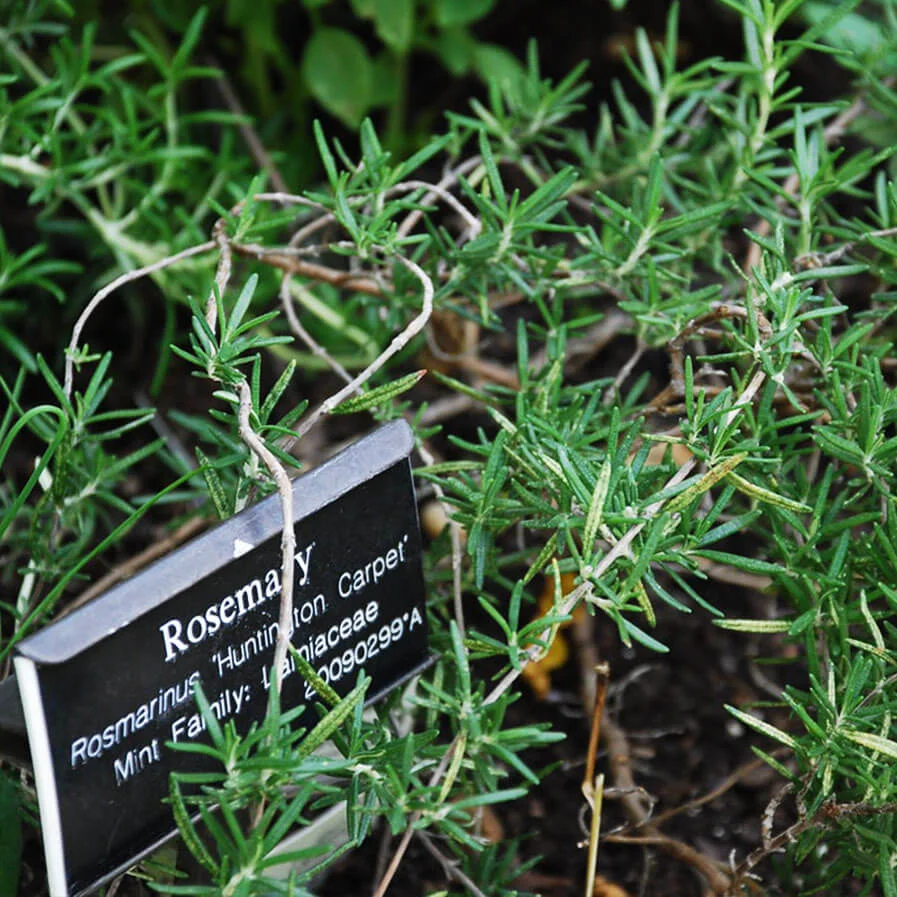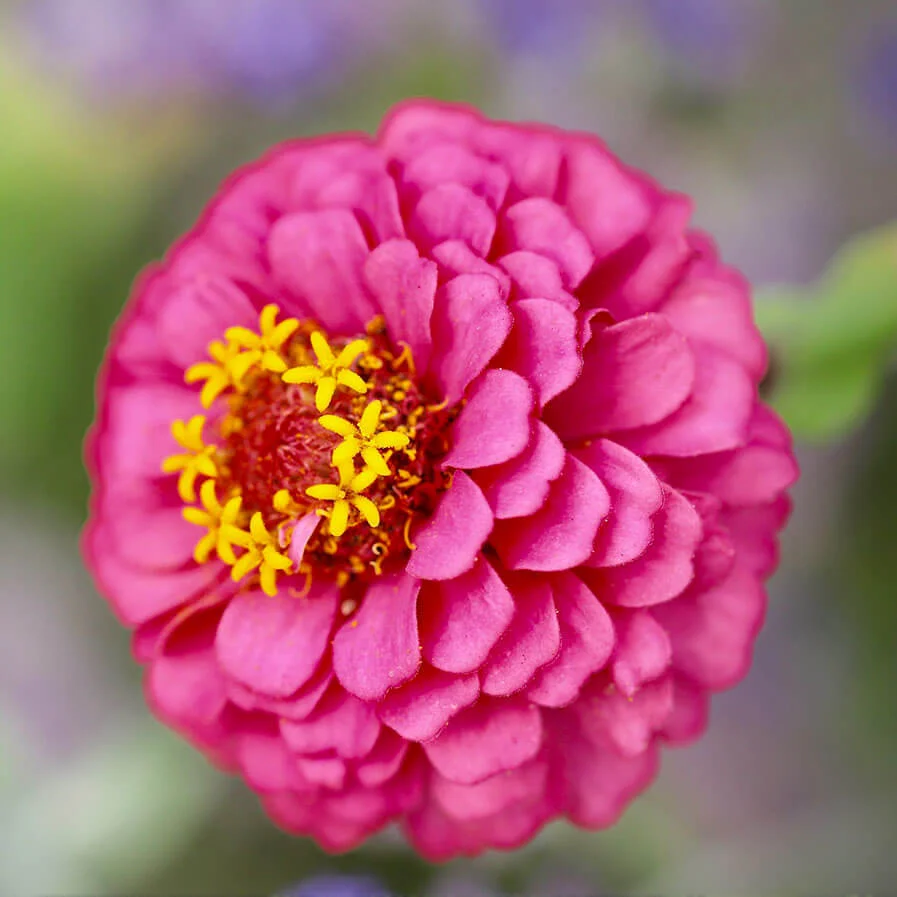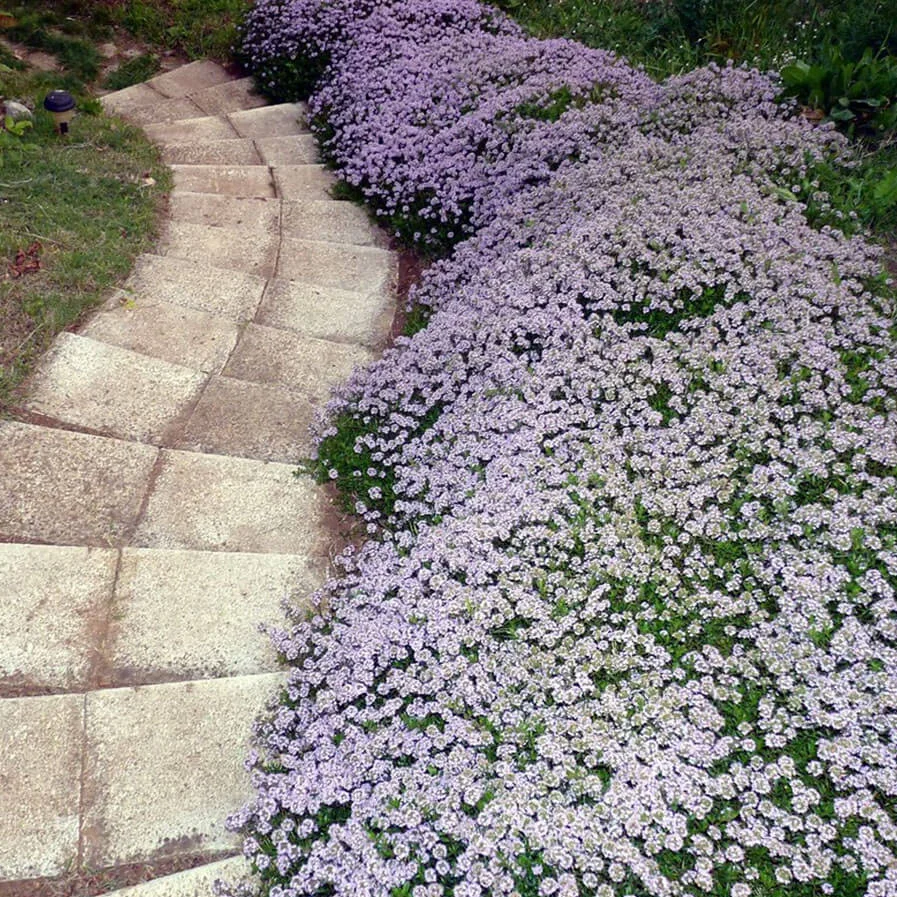
Rosemary Huntington Carpet
Quick links to save you time
Why grow rosemary?
Rosemary is an exceptional herb that’s simple to cultivate and has numerous applications. Here are some reasons why you should consider growing rosemary:
- Flavorful: Rosemary adds beautiful flavor and aroma to everything from bread to chicken. It is simple to use and available to harvest all year round.
- Versatile: You can incorporate rosemary into various culinary creations, including marinades, rubs, and sauces.
- Health benefits: Traditionally, people used rosemary to relieve muscle pain, sharpen memory, bolster the circulatory and immune systems, and stimulate hair growth.
- Drought-resistant: Rosemary is a drought-resistant plant that can thrive in hot, dry conditions.
- Easy to grow: Growing Rosemary is straightforward, whether in gardens or pots. It thrives in full sunlight and prefers light, well-draining soil with pH levels between 6 and 7.
- Attractive: Rosemary is a captivating evergreen shrub for landscaping uses like hedges, borders, and herb gardens.
- Fragrant: Rosemary emits a lovely scent that can enrich the ambiance of your garden or home.
Rosemary in Landscaping

Rosemary Allegory
Credit Alberto Conde Kitchen In The Med
Rosemary is suitable for a range of landscaping purposes. It can be grown as an evergreen hedge, a border plant, or in herb gardens. Varieties such as Heavenly Blue exhibit low, sprawling growth, making them ideal for draping over walls or as a ground cover. Rosemary can also be grown in containers and trained into topiary shapes. Its salt spray tolerance makes it a good choice for pots on the beach.
Rosemary Varietals

Tuscan Blue Rosemary
Many varietals have different growth habits, foliage, and flower colors. Some popular Rosemary varietals include:
- ‘Tuscan Blue’: A flavorful variety with lemony notes and pine flavor.

Rosmarinus officinalis Prostratus Gorizia
- ‘Gorizia’: A bold, rich-flavored Rosemary.

Spice Island Rosemary
- ‘Spice Island’: A multifaceted taste featuring subtle undertones of clove and nutmeg.

Salem Rosemary
- ‘Salem’: A mellower Rosemary flavor.

Arp Rosemary
- ‘Arp’ is a cold-hardy variety that can tolerate temperatures up to -10°F.

Madeline Hill Rosemary
- ‘Madeline Hill’: A cold-hardy variety that can handle temperatures around 0°F.

Heavenly Blue blooming Rosemary
- ‘Heavenly Blue’: A unique, low-spreading variety known as ‘creeping Rosemary.’
How to How to Grow Rosemary in Gardens and Containers

rosemary with lavandula stoechas
Credit Alberto Conde Kitchen in the Med
- Choose the right location: Rosemary flourishes in sunny, protected places with well-draining soil. Heavy clay soils, especially during the wetter winter, can challenge its growth.
- Plant at the right time: Plant Rosemary in spring once there’s no longer a risk of frost. In warmer climates, you can plant Rosemary from October to April.
- Improve soil: Mix several inches of aged compost or rich organic matter into your native soil before planting.
- Space plants properly: Space Rosemary plants 2 to 3 feet or just under a meter apart to provide satisfactory air circulation and space for growth.
- Water appropriately: Maintain the soil constantly damp but not wet. Wait for the top inch of soil to become dry before watering again.
- Fertilize: Feed your Rosemary plant with a slow-release fertilizer or an organic product like fish emulsion, greensand, or kelp meal.
- Prune and harvest: Prune your Rosemary plant carefully to encourage new development and keep its shape. The best time to prune is in the spring. Harvest rosemary by snipping off the leaves into small pieces while holding the stem in your hand.

Rosemary in a pot
Growing Rosemary in Pots or Containers
Growing rosemary in pots is a great way to cultivate this fragrant herb, especially if you live in colder zones or have limited garden space. To grow rosemary in pots, follow these steps:
- Choose the suitable container: Select a pot with good drainage holes to prevent waterlogging. Terra cotta pots work well for cultivating rosemary since they let the soil dry between watering sessions.
- Use well-draining soil: Rosemary prefers light, well-drained soil with a pH between 6 and 7. Improve the soil with aged compost-enriched potting mix.
- Plant in full sun: Rosemary thrives in full sunlight, so place your pot in an area that receives at least six to eight hours daily.
- Water appropriately: Maintain the soil consistently damp but not wet. Wait for the top inch of soil to become dry before watering again.
- Fertilize: Feed your Rosemary plant with a slow-release fertilizer or an organic product like fish emulsion, greensand, or kelp meal.
- Prune and harvest: Prune your Rosemary plant carefully to encourage new growth and hold its shape. The best time to prune is in the spring—harvest rosemary by snipping off the leaves into small pieces while holding the stem in your hand.
4 Essential Tips for Growing Rosemary

Rosemary Gorizia
- Plant at the right time: Plant Rosemary in spring once there’s no longer a risk of frost. In warmer climates, you can plant Rosemary from October to April.
- Space plants properly: Space Rosemary plants 2 to 3 feet or just under a meter apart to provide satisfactory air circulation and space for development.
- Improve soil: Mix several inches of aged compost or rich organic matter into your native soil before planting.
- Propagate from cuttings: Propagating Rosemary is more straightforward than growing from seeds. Take a 4-6 inch cutting from the end of a stem and plant it in moist vermiculite or sand.
Is Rosemary safe for pets?

Chinook and Rosemary
Rosemary is generally considered safe for pets, including dogs and cats. According to the ASPCA, Rosemary is non-toxic to dogs, cats, and horses. However, there are some things to keep in mind when it comes to pets and rosemary:
- Your pets should avoid Rosemary essential oil because it poses a toxicity risk, whether consumed or applied to the skin.
- While rosemary is generally safe for pets, it is always a good idea to start with a small amount to see how your pet responds.
- If your pet has any illnesses or is taking medication, it is best to consult your veterinarian before giving them rosemary.
- If you have rosemary plants in your garden, ensure your pets do not ingest too much of them, as they can cause gastrointestinal upset.
Pruning Rosemary

Pruning Rosemary
Why Prune Rosemary?
- Promote Growth: Pruning encourages new growth by removing old, woody stems. It makes the plant bushier and more vigorous, enhancing its overall health.
- Maintain Shape: Regular pruning helps maintain the desired shape and size of the plant. It is essential if you are growing rosemary in a container or as part of a formal garden design.
- Prevent Legginess: Without pruning, rosemary can become leggy, with long, spindly stems and sparse foliage. Pruning helps keep the plant compact and full.
- Increase Airflow: Pruning improves airflow within the plant, lowering the chance of fungal diseases and pest infestations. Good airflow also helps the plant dry out quickly after rain, further preventing disease.
- Enhance Flavor: Regularly pruned rosemary tends to have more tender and flavorful leaves, making it better for culinary use.
- Remove Dead or Damaged Parts: Pruning removes any dead, damaged, or diseased branches, preventing the spread of disease and allowing the plant to focus its energy on healthy growth.
When to Prune Rosemary
Spring (after the last frost): Pruning in spring promotes new growth. It encourages the plant to become bushier and more vigorous. Aim to prune after the last frost date to avoid cold damage to the newly cut branches.
After flowering (late spring to early summer): If your rosemary flowers, wait until the blooms fade before pruning. This timing allows the plant to direct its energy into new growth rather than flowering.
Light pruning throughout the growing season: You can lightly trim rosemary as needed during the growing season to harvest leaves or maintain shape. Do not prune heavily late in the season, or the plant will stress before the winter.
Avoid late fall or winter pruning: It can leave the plant vulnerable to cold damage, as new growth stimulated by pruning might not harden off before frost.

Pruning Rosemary
How to Prune Rosemary
- Use Sharp, Clean Tools: Use sharp pruning shears or scissors to make clean cuts. Clean tools prevent the spread of disease.
- Identify the Right Branches: First, look for dead, damaged, or woody stems to remove. Also, identify long, leggy branches that need trimming to maintain the plant’s shape.
- Cut Above a Leaf Node: When pruning, cut just above a leaf node (where leaves join the stem) to encourage new growth. Avoid cutting into the woody part of the stem, as rosemary may not regrow from old wood.
- Shape the Plant: Trim back the outer stems to shape the plant and keep it compact. Aim to reduce the overall height by one-third during each significant pruning session.
- Remove Dead or Diseased Branches: Cut these branches back to the base to prevent the spread of disease and encourage healthy growth.
Additional Tips and recap on Pruning Rosemary
- Regular Light Pruning: Prune lightly throughout the growing season to hold shape and promote steady growth. Harvesting for culinary use counts as light pruning.
- Prune in Spring or Early Summer: Major pruning should occur in spring, after the last frost, or early summer after flowering. This timing promotes robust new growth.
- Avoid Heavy Pruning Late in the Season: Heavy pruning late in the growing season can stress the plant before winter. You can still do some light trimming as needed.
- Mulch and Water After Pruning: After pruning, spread a coating of mulch about the base of the plant and water it well. It helps reduce stress and supports recovery.
- Monitor for Pests and Diseases: Watch for symptoms of pests or diseases, like discolored leaves or uncommon growth patterns. Pruning can help manage these issues by improving airflow.
Propagating Rosemary, a step-by-step Guide

Rosemary
- Select Healthy Parent Plant: Choose a healthy rosemary plant free from disease and pests. The parent plant should have robust and non-woody stems.
- Take Cuttings:
- Timing: The most suitable time to take cuttings is when the plant grows in late spring or early summer.
- Tools: Use sharp, clean scissors or pruning shears.
- Cutting Length: Cut a 4-6 inch (10-15 cm) section of a non-woody stem just below a leaf node.
- Preparation: Strip the leaves from the bottom half of the cutting, leaving a few sets of leaves at the top.
- Optional: Dip in Rooting Hormone:
- Rooting hormone can help stimulate root growth, though it is not essential.
- Dip the stripped end of the cutting into the rooting hormone powder or gel.
- Plant the Cuttings:
- Soil: Use a well-draining soil mix, such as sand, perlite, and peat moss.
- Containers: Plant the cuttings in small pots or a seed tray.
- Depth: Insert the cuttings about 2 inches (5 cm) deep into the soil.
- Water and Cover:
- Water the soil lightly to keep it moist but not soggy.
- Cover the pots with a plastic film or bag, or use a propagator to create a humid environment that maintains moisture.
- Place in Indirect Light:
- Place the cuttings in a warm area with indirect light. Avoid full sunlight, which can scorch them.
- Maintain humidity by misting the cuttings occasionally if they are not covered.
- Monitor and Wait for Rooting:
- Check the cuttings regularly for moisture and root development.
- Roots typically develop in 2-4 weeks. You can check if they have been created by gently tugging on the cutting to feel if it has resistance, indicating root growth.
- Transplant the Rooted Cuttings:
- Once the cuttings have established roots, transplant them into larger containers or the garden.
- Gradually acclimate the new plants to outdoor conditions if you plan to plant them outside.

Cuttings of Rosemarinus officinalis Tuscan Blue under a dome on the rooting bench
Tips and recap for Successful Rosemary Propagation
- Avoid Overwatering: Rosemary cuttings can rot if the soil stays too wet. Ensure good drainage and water sparingly.
- Use Fresh, Healthy Cuttings: Older, woody stems are less likely to root successfully.
- Humidity Control: Maintaining high humidity around the cuttings helps prevent them from drying out before they root.
- Patience is Key: Root development can take weeks, so be patient and avoid tugging on the cuttings too often.
Troubleshooting Rosemary: Growing Problems, Pests, and Diseases

Sick Rosemary
Growing Problems
Leggy Growth:
- Cause: Insufficient light.
- Solution: Move it to a sunnier location. Prune to encourage bushier growth.
Yellowing Leaves:
- Cause: Overwatering or poor drainage.
- Solution: Let the soil dry out before you water the plant. Ensure the pot or garden bed has good drainage.
Slow Growth:
- Cause: Poor soil quality or lack of nutrients.
- Solution: Use well-draining, sandy soil. Fertilize lightly with a balanced fertilizer.

The larva stage of the Frog Hopper Aphid on Rosemary
Pests
Aphids:
- Symptoms: Small green, black, or white insects on new growth. Sticky residue on leaves.
- Solution: Spray with a mixture of water and a few drops of dish soap. Introduce natural predators like ladybugs.
Spider Mites:
- Symptoms: Fine webbing on leaves and stems. Leaves may look stippled or bronzed.
- Solution: Increase humidity around the plant. Spray with insecticidal soap or neem oil.
Whiteflies:
- Symptoms: Small white insects that fly up when the plant is disturbed. Sticky residue on leaves.
- Solution: Use yellow sticky traps. Spray with insecticidal soap.

White fly
Diseases
Powdery Mildew:
- Symptoms: Unusual white, “powdery” spots appear on leaves and stems.
- Solution: Improve air circulation around the plant. Avoid overhead watering. Apply a fungicide if necessary.
Root Rot:
- Symptoms: Wilting, yellowing leaves, and mushy roots.
- Solution: Remove affected parts of the plant. Repot in well-draining soil. Avoid overwatering.
Downy Mildew:
- Symptoms: Yellow or white spots on the upper leaf surface, with a grayish fuzz on the underside.
- Solution: Ensure good air circulation. Water at the base of the plant to keep leaves dry. Apply fungicides if needed.
10 Great Plants to Place next to Rosemary

Zinnia
Zinnias (Zinnia spp.)
Zinnias are highly attractive to pollinators and can be a top choice for cutting gardens.

Thyme Hedge
Thyme (Thymus vulgaris)
Thyme and Rosemary are both members of the Lamiaceae family and have similar growing requirements. Thyme can also help repel pests and attract pollinators to your garden.

White Sage
Sage (Salvia officinalis)
Sage and Rosemary thrive in similar growing conditions, making them excellent companions.

Green Bean Plant
Beans (Phaseolus spp.)
Beans are a suitable companion plant for rosemary because they also fix nitrogen in the ground.

Strawberry Plant
Strawberries (Fragaria × ananassa)
Strawberries are a fantastic companion plant for rosemary because they fix nitrogen in the ground.

Sweet Marjoram
Marjoram (Origanum majorana)
Marjoram is similar to oregano, with comparable growing needs. It can also help deter pests and attract beneficial insects to your garden.

Lobularia Maritima
Alyssum (Lobularia maritima)
Alyssum’s tiny flowers are beautiful to bees and other beneficial insects. They can also help improve soil health.

Marygolds
Marigolds (Tagetes spp.)
Marigolds deter pests, draw helpful insects to your garden, and inject a vibrant splash of color into the setting.

Oregano
Oregano (Origanum vulgare)
Oregano is another member of the Lamiaceae family and has similar growing requirements to rosemary. It can also help repel pests and attract beneficial insects to your garden.

Lavender in a hedge
Lavender (Lavandula angustifolia)
Rosemary and Lavender are members of the Lamiaceae family and have similar growing requirements. Lavender can also help repel pests and attract pollinators to your garden.
9 Plants to avoid planting next to Rosemary

Ornamental Brassica
- Broccoli
- Brussels sprouts
- Cabbage
- Cauliflower
- Fennel
- Cucumbers
- Pumpkins
- Spearmint
- Peppermint
These plants are either prone to fungal diseases or can compete with rosemary for nutrients. Mint spreads aggressively and can dominate garden beds rapidly, so you should refrain from planting it alongside rosemary.
Other plants similar to Rosemary

Russian Sage
Some of these plants are members of the mint family, including rosemary, and share similar characteristics, such as square stems and opposite leaves. Some of these plants also have fragrant leaves and flowers and have culinary or medicinal applications.
- Russian Sage (Perovskia atriplicifolia)
- Lavender (Lavender angustifolia)
- American Pennyroyal (Hedeoma pulegioides)
- Canadian Horseweed (Conyza canadensis)
- Narrowleaf Mountain Mint (Pycanthemum tenuifolium)
- Rough False Pennyroyal
- Curry Plant (Helichrysum italicum)
- Virginia Mountain Mint (Pycanthemum virginianum)
- Dog Fennel
- Chamaemelum
- Eupatorium capillifolium
- Anthemis cotula
Rosemary, compared to other popular herbs

Rosemary
Credit Alberto Conde Kitchen in the Med
Rosemary
- Growing conditions: Rosemary likes full sun and well-draining soil, and it’s drought tolerant.
- Characteristics: Rosemary has a piney, resinous flavor with needle-like dark green leaves. It is popular in roasts, grilled meats, marinades, and bread.
Marjoram
- Growing conditions: Marjoram is a tender perennial herb that prefers well-drained soil and full sun. It is not frost-tolerant and needs warm temperatures to grow.
- Characteristics: Marjoram has somewhat felty green to gray-green leaves and tiny similarly colored crenelated buds with a bit of white flower. They thrive on wiry stems that form a full burst of branches, kept bushy by regularly harvesting the growth. It is crucial in Mediterranean and Middle Eastern cuisine. It is a good companion plant for many other herbs and vegetables.
Basil
- Growing conditions: Basil favors warm, sunny locations with well-draining soil and prospers in Mediterranean climates.
- Characteristics: Basil has a sweet, peppery savor with large, tender leaves varying from green to purple. It’s very popular in Italian dishes, pesto, salads, and garnish.
Cardamom
- Growing conditions: Cardamom flourishes in warm, humid climates with spotted sunlight and well-draining soil.
- Characteristics: Cardamom has a warm, citrusy taste with floral undertones. The little green pods have a papery outer shell. People use it in curries, desserts, and beverages.
Thyme
- Growing conditions: Thyme thrives in sunny areas with well-draining soil and is drought-tolerant.
- Characteristics: Thyme has an earthy, slightly peppery, and lemony taste, with little gray-green leaves. People use it in soups, stews, roasts, and marinades.
Oregano
- Growing conditions: Oregano prospers in full sun with well-draining soil and is drought-tolerant.
- Characteristics: Oregano has a bold, intense, and scarcely bitter flavor with little green leaves and groups of white flowers. It’s a staple herb in Mediterranean cuisine, used in pizzas, pasta, salads, and marinades.
Sage
- Growing conditions: Sage likes full sun and well-draining soil, and it’s drought tolerant.
- Characteristics: Sage has an earthy, peppery, and savory taste with fuzzy gray-green leaves. People use it in stuffing, poultry dishes, sauces, and roasted vegetables.

Hungarian Queens Water a Rosemary Herbal concoction
The most frequently asked questions about growing Rosemary
Can rosemary grow in the shade?
While rosemary can manage in partial shade, it won’t flourish in complete shade. It needs a minimum of 6 hours of full sunlight daily to prosper.
Can rosemary survive winter?
Rosemary is a perennial plant that can withstand winter when shielded from frost and chilling temperatures. It can also be grown indoors during the winter months.
Will rosemary grow back after winter?
Rosemary will grow back in the spring if adequately protected during the winter. But if cold temperatures or frost harm it, it may not survive.
Can rosemary grow indoors?
Yes, rosemary can be grown indoors with proper care and handling. It needs bright, direct sunlight and well-draining soil.
Why do people plant rosemary by the garden gate?
People often do this as a symbol of remembrance and to ward off evil spirits.
Are Rosemary and Lavender related?
Yes, Rosemary and Lavender are both members of the Lamiaceae family and have similar growing requirements and characteristics.
Can I plant rosemary near blueberries?
Yes, you can. It helps repel pests and attract beneficial insects to your garden.
Can I plant rosemary near tomatoes?
Yes, it helps repel pests and attract beneficial insects to your garden.
Are Rosemary plants perennials?
Yes, rosemary is a perennial plant that can live for several years if properly cared for.
Will rosemary root in water?
Yes, rosemary can root in water, but it is best to use a rooting hormone to increase the chances of success.
Why do Rosemary leaves turn yellow?
Rosemary leaves may turn yellow due to overwatering, poor drainage, or nutrient deficiencies.
Why is my rosemary turning brown?
Rosemary may turn brown due to underwatering, overfertilization, or pest infestations.
Why is my Rosemary plant not growing?
Rosemary’s growth might stall because of inadequate sunlight, subpar soil, or pests. Ensuring the plant receives ample sunlight and water and confirming that the soil drains well is crucial.
How do you harvest rosemary?
You can collect rosemary by snipping sprigs from the plant using scissors or pruning shears. For optimal oil concentration, it’s advisable to harvest in the morning.
While rosemary can manage in partial shade, it won’t flourish in complete shade. It needs a minimum of 6 hours of full sunlight daily to prosper.
Rosemary is a perennial plant that can withstand winter when shielded from frost and chilling temperatures. It can also be grown indoors during the winter months.
Rosemary will grow back in the spring if adequately protected during the winter. But if cold temperatures or frost harm it, it may not survive.
Yes, rosemary can be grown indoors with proper care and handling. It needs bright, direct sunlight and well-draining soil.
People often do this as a symbol of remembrance and to ward off evil spirits.
Yes, Rosemary and Lavender are both members of the Lamiaceae family and have similar growing requirements and characteristics.
Yes, you can. It helps repel pests and attract beneficial insects to your garden.
Yes, it helps repel pests and attract beneficial insects to your garden.
Yes, rosemary is a perennial plant that can live for several years if properly cared for.
Yes, rosemary can root in water, but it is best to use a rooting hormone to increase the chances of success.
Rosemary leaves may turn yellow due to overwatering, poor drainage, or nutrient deficiencies.
Rosemary may turn brown due to underwatering, overfertilization, or pest infestations.
Rosemary’s growth might stall because of inadequate sunlight, subpar soil, or pests. Ensuring the plant receives ample sunlight and water and confirming that the soil drains well is crucial.
You can collect rosemary by snipping sprigs from the plant using scissors or pruning shears. For optimal oil concentration, it’s advisable to harvest in the morning.
Main Sources I used in This Article
Taylor & Francis Online
International Jouirnal of Scientific Research and Engineering Development
MDPI Multidisciplinary Digital Publishing Institute
Springer Link
ISHS Acta Horticulturae 629
XXVI International Horticultural Congress: The Future for Medicinal and Aromatic Plants
ScienceDirect
Trends in Food Science & Technology
Volume 45, Issue 2, October 2015
A novel insight on an ancient aromatic plant: The rosemary (Rosmarinus officinalis L.)
journals at lippincott
Holistic Nursing Practice
HERBALS AND NUTRITIONAL SUPPLEMENTS
Aromatic Plants, Spirituality, and Sacred Traditions II
Malta Wild Plants
CABI Digital Library
How to Grow Rosemary Plants: The Complete Guide
XXVI International Horticultural Congress: The Future for Medicinal and Aromatic Plants
Trends in Food Science & Technology
Volume 45, Issue 2, October 2015
A novel insight on an ancient aromatic plant: The rosemary (Rosmarinus officinalis L.)
Holistic Nursing Practice
HERBALS AND NUTRITIONAL SUPPLEMENTS
Aromatic Plants, Spirituality, and Sacred Traditions II
3 Responses